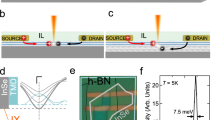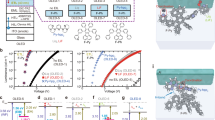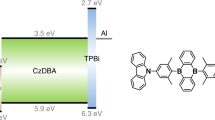Abstract
Field-effect transistors are emerging as useful device structures for efficient light generation from a variety of materials, including inorganic semiconductors, carbon nanotubes and organic thin films. In particular, organic light-emitting field-effect transistors are a new class of electro-optical devices that could provide a novel architecture to address open questions concerning charge-carrier recombination and light emission in organic materials. These devices have potential applications in optical communication systems, advanced display technology, solid-state lighting and electrically pumped organic lasers. Here, recent advances and future prospects of light-emitting field-effect transistors are explored, with particular emphasis on organic semiconductors and the role played by the material properties, device features and the active layer structure in determining the device performances.
This is a preview of subscription content, access via your institution
Access options
Subscribe to this journal
Receive 12 print issues and online access
$259.00 per year
only $21.58 per issue
Buy this article
- Purchase on Springer Link
- Instant access to full article PDF
Prices may be subject to local taxes which are calculated during checkout




Similar content being viewed by others
References
Malliaras, G. & Friend, R. H. An organic electronics primer. Phys. Today 58, 53–58 (2005).
Shaheen, S. E. et al. 2.5% efficient organic plastic solar cells. Appl. Phys. Lett. 78, 841–843 (2001).
Peumans, P., Uchida, S. & Forrest, S. R. Efficient bulk heterojunction photovoltaic cells using small-molecular-weight organic thin films. Nature 425, 158–162 (2003).
Gundlach, D. J., Lin, Y. Y., Jackson, T. N., Nelson, S. F. & Schlom, D. G. Pentacene organic thin-film transistors—molecular ordering and mobility. IEEE Electron. Dev. Lett. 18, 87–89 (1997).
Forrest, S. R. The path to ubiquitous and low-cost organic electronic appliances on plastic. Nature 428, 911–918 (2004).
Sirringhaus, H., Tessler, N. & Friend, R. H. Integrated optoelectronic devices based on conjugated polymers. Science 280, 1741–1744 (1998).
Kuo, C. T. & Weng, S. Z. Integrated device based on conjugated oligoaniline. Polymers for Adv. Tech. 13, 753–758 (2002).
Hepp, A. et al. Light-emitting field-effect transistor based on a tetracene thin film. Phys. Rev. Lett. 91, 157406 (2003).
Rost, C. et al. Ambipolar light-emitting organic field-effect transistor. Appl. Phys. Lett. 85, 1613–1615 (2004).
Cullis, A. G., Canham, L. T. & Calcott, P. D. J. The structural and luminescence properties of porous silicon. J. Appl. Phys. 82, 909–965 (1997).
Walters, R. J., Bourianoff, G. I. & Atwater, H. A. Field-effect electroluminescence in silicon nanocrystals. Nature Mater. 4, 143–146 (2005).
Feng, M., Holonyak, Jr, N. & Hafez, W. Light-emitting transistor: Light emission from InGaP/GaAs heterojunction bipolar transistors. Appl. Phys. Lett. 84, 151–153 (2004).
Walters, G., Holonyak, N. Jr, Feng, M. & Chan, R. Laser operation of a heterojunction bipolar light-emitting transistor. Appl. Phys. Lett. 85, 4768–4770 (2004).
Feng, M., Holonyak, N. Jr, Walters, G. & Chan, R. Room temperature continuous wave operation of a heterojunction bipolar transistor laser. Appl. Phys. Lett. 87, 131103 (2005).
Duan, X., Huang, Y., Cui, Y., Wong, J. & Lieber, C. M. Indium phosphide nanowires as building blocks for nanoscale electronic and optoelectronic devices. Nature 409, 66–69 (2001).
Gudiksen, M. S., Lauhon, L. J., Wong, J., Smith, D. C. & Lieber, C. M. Growth of nanowire superlattice structures for nanoscale photonics and electronics. Nature 415, 617–620 (2002).
Misewich, J. A. et al. Electrically induced optical emission from a carbon nanotube FET Science 300, 783–786 (2003).
Derycke, V., Martel, R., Appenzeller, J. & Avouris, Ph. Carbon nanotube inter- and intramolecular logic gates. Nano Lett. 1, 453–456 (2001).
Liu, X., Lee, C., Zhou, C. & Han, J. Carbon nanotube field-effect inverters. Appl. Phys. Lett. 79, 3329–3331 (2001).
Bachtold, A., Hadley, P., Nakanishi, T. & Dekker, C. Logic circuits with carbon nanotube transistors. Science 294, 1317–1320 (2001).
Bachilo, S. M. et al. Structure-assigned optical spectra of single-walled carbon nanotubes Science 298, 2361–2366 (2002).
Barbarella, G., Melucci, M. & Sotgiu, G. The versatile thiophene: an overview of recent research on thiophene-based materials. Adv. Mater. 17, 1581–1593 (2005).
Facchetti, A., Mushrush, M., Katz, H. E. & Marks, T. J. n-type building blocks for organic electronics: a homologous family of fluorocarbon-substituted thiophene oligomers with high carrier mobility. Adv. Mater. 15, 33–38 (2003).
Furuta, P. T., Deng, L., Garon, S., Thompson, M. E. & Frechet, J. M. Platinum-functionalized random copolymers for use in solution-processible, efficient, near-white organic light-emitting diodes. J. Am. Chem. Soc. 126, 15388–15389 (2004).
Yoon, M. H., DiBenedetto, S. A., Facchetti, A. & Marks, T. J. Organic thin-film transistors based on carbonyl-functionalized quaterthiophenes: high mobility n-channel semiconductors and ambipolar transport. J. Am. Chem. Soc. 127, 1348–1349 (2005).
Dinelli, F. et al. Spatially correlated charge transport in organic thin film transistors. Phys. Rev. Lett. 92, 116802 (2004).
Cicoira, F. et al. Morphology and field-effect-transistor mobility in tetracene thin films. Adv. Funct. Mater. 15, 375–380 (2005).
Santato, C. et al. Tetracene-based organic light-emitting transistors: optoelectronic properties and electron injection mechanism. Synth. Metals 146, 329–334 (2004).
Reynaert, J. et al. Ambipolar injection in a submicron-channel light-emitting tetracene transistor with distinct source and drain contacts. J. Appl. Phys. 97, 114501 (2005).
Verlaak, S., Cheyns, D., Debucquoy, M., Arkhipov, V. & Heremans, P. Numerical simulation of tetracene light-emitting transistors: a detailed balance of exciton processes. Appl. Phys. Lett. 85, 2405–2407 (2004).
Oyamada, T. et al. Electroluminescence of 2,4-bis(4-(2′-thiophene-yl) phenyl)thiophene in organic light-emitting field-effect transistors. Appl. Phys. Lett. 86, 093505 (2005).
Oyamada, T. et al. Lateral organic light-emitting diode with field-effect transistor characteristics. J. Appl. Phys. 98, 074506 (2005).
Ahles, M., Hepp, A., Schmechel, R. & von Seggern, H. Light emission from a polymer transistor. Appl. Phys. Lett. 84, 428–430 (2004).
Sakanoue, T., Fujiwara, E., Yamada, R. & Tada, H. Visible light emission from polymer-based field-effect transistors. Appl. Phys. Lett. 84, 3037–3039 (2004).
Swensen, J., Moses, D. & Heeger, A. J. Light emission in the channel region of a polymer thin-film transistor fabricated with gold and aluminum for the source and drain electrodes. Synth. Metals 153, 53–56 (2005).
Cicoira, F. et al. Organic light-emitting transistors based on solution-cast and vacuum-sublimed films of a rigid core thiophene oligomer. Adv. Mater. 18, 169–174 (2006).
Crone, B. et al. Large-scale complementary integrated circuits based on organic transistors Nature 403, 521–523 (2000).
Meijer, E. J. et al. Solution-processed ambipolar organic field-effect transistors and inverters. Nature Mater. 2, 678–682 (2003).
Freitag, M. et al. Mobile ambipolar domain in carbon-nanotube infrared emitters. Phys. Rev. Lett. 93, 076803 (2004).
Karl, N. Charge carrier transport in organic semiconductors. Synth. Met. 133–134, 649–657 (2003).
Dimitrakopoulos, C. D. & Malenfant, P. R. L. Organic thin film transistors for large area electronics. Adv. Mater. 14, 99–117 (2002).
Chesterfield, R. J. High electron mobility and ambipolar transport in organic thin-film transistors based on a π-stacking quinoidal terthiophene. Adv. Mater. 15, 1278–1282 (2003).
Chua, L. L. et al. General observation of n-type field-effect behaviour in organic semiconductors. Nature 434, 194–199 (2005).
Corcoran, N., Arias, A. C., Kim, J. S., MacKenzie, J. D. & Friend, R. H. Increased efficiency in vertically segregated thin-film conjugated polymer blends for light-emitting diodes. Appl. Phys. Lett. 82, 299–301 (2003).
Alam, M. M., Tonzola, C. J. & Jenekhe, S. A. Nanophase-separated blends of acceptor and donor conjugated polymers. efficient electroluminescence from binary polyquinoline/poly(2-methoxy-5-(2′-ethylhexyloxy)-1,4-phenylenevinylene) and polyquinoline/poly(3-octylthiophene) blends. Macromolecules 36, 6577–6587 (2003).
Arias, A. C. et al. Photovoltaic performance and morphology of polyfluorene blends: a combined microscopic and photovoltaic investigation. Macromolecules 34, 6005–6013 (2001).
Tada, K., Harada, H. & Yoshino, K. Polymeric bipolar thin-film transistor utilizing conducting polymer containing electron transport dye. Jpn J. Appl. Phys. 35, L944–L946 (1996).
Melucci, M. et al. Multiscale self-organization of the organic semiconductor α-quinquethiophene. J. Am. Chem. Soc. 125, 10266–10274 (2003).
Malenfant, P. R. L. et al. N-type organic thin-film transistor with high field-effect mobility based on a N,N′-dialkyl-3,4,9,10-perylene tetracarboxylic diimide derivative. Appl. Phys. Lett. 80, 2517–2519 (2002).
Loi, M. A. et al. Tuning optoelectronic properties of ambipolar organic light- emitting transistors using a bulk-heterojunction approach. Adv. Funct. Mater. 16, 41–47 (2006).
Dinelli, F. et al. High-mobility ambipolar transport in organic light-emitting transistors. Adv. Mater. 18, 1416–1420 (2006).
Swensen, J. S., Soci, C. & Heeger, A. J. Light emission from an ambipolar semiconducting polymer field-effect transistor. Appl. Phys. Lett. 87, 253511 (2005).
Zaumseil, J., Friend, R. H. & Sirringhaus, H. Spatial control of the recombination zone in an ambipolar light-emitting organic transistor. Nature Mater. 5, 69–74 (2006).
Singh, Th. B. et al. High-performance ambipolar pentacene organic field-effect transistors on poly(vinyl alcohol) organic gate dielectric. Adv. Mater. 17, 2315–2320 (2005).
Tessler, N. et al. Pulsed excitation of low-mobility light-emitting diodes: Implication for organic lasers. Appl. Phys. Lett. 74, 2764–2766 (1999).
Baldo, M. A., Holmes, R. J. & Forrest, S. R. Prospects for electrically pumped organic lasers. Phys. Rev. B 66, 035321 (2002).
Santato, C. et al. Tetracene light-emitting transistors on flexible plastic substrates. Appl. Phys. Lett. 86, 141106 (2005).
Acknowledgements
The author is indebted to many co-workers for the extensive work and exciting discussions on the topic of OLETs. Special thanks go to R. Zamboni, R. Capelli, M. Murgia, F. Dinelli, M. A. Loi, C. Santato, F. Cicoira, F. Todescato, S. Toffanin, C. Rost, S. F. Karg, W. Riess, A. Facchetti, T.J. Marks. Financial support from Italian MIUR project FIRB–RBNE033KMA and EU project FP6-IST-015034 OLAS is kindly acknowledged.
Author information
Authors and Affiliations
Rights and permissions
About this article
Cite this article
Muccini, M. A bright future for organic field-effect transistors. Nature Mater 5, 605–613 (2006). https://doi.org/10.1038/nmat1699
Issue Date:
DOI: https://doi.org/10.1038/nmat1699
This article is cited by
-
Controlling doping efficiency in organic semiconductors by tuning short-range overscreening
Nature Communications (2023)
-
A study of highly efficient organic light emitting transistors that outperforms organic light emitting diodes
Optical and Quantum Electronics (2023)
-
Light sources with bias tunable spectrum based on van der Waals interface transistors
Nature Communications (2022)
-
Macro- and atomic-scale observations of a one-dimensional heterojunction in a nickel and palladium nanowire complex
Nature Communications (2022)
-
Organic light emitting transistors: performance analysis and high performance device
Analog Integrated Circuits and Signal Processing (2022)



